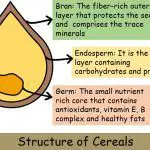Though both the molecules contain carbon and oxygen, the general difference between them lies in their number of oxygen of atoms carried by them; as carbon dioxide (CO2) has one carbon atom and two oxygen atoms, while carbon monoxide (CO) has one carbon and one oxygen atom. Carbon Dioxide is naturally present in our atmosphere and as it is excreted out during the process … [Read more...] about Difference Between Carbon Dioxide (CO2) and Carbon Monoxide (CO)
Difference Between Cereals and Pulses
Cereals and Pulses are the types of foods obtained from plants. They serve their individual roles in our bodies, and thus both are equally important in a balanced diet. We consume them in one or the other form daily, which makes it important for us to know more about them. So, let’s start! The cereals are a rich source of carbohydrates and starch. They provide the human … [Read more...] about Difference Between Cereals and Pulses
Difference Between Weather and Climate
The main difference between these two terms is the duration. The weather is the day-to-day or short-term condition of the changes in the atmosphere. And, the climate is the average weather condition of a particular place over a long time, about 30 years. Like for instance, we talk about the weather in terms of "hot it will be today?" "Will it rain or not"? Or "What about the … [Read more...] about Difference Between Weather and Climate
Difference Between Evergreen and Deciduous Forests
The critical and the common distinction between the two types of forests is the in 'Evergreen forests' as the name says the trees do not shed their leaves in any season, until and unless they are old which are soon replaced by the others. On the other hand, 'Deciduous forests' shed their leaves in the dry season to save the water loss. Evergreen Forests are found in the area … [Read more...] about Difference Between Evergreen and Deciduous Forests
Difference Between Humoral and Cell-Mediated Immunity
The primary difference between them is the mechanism of immunity, where the Humoral immunity produces antibodies against the antigens which are present outside the infected cells or free circulating in the blood. Cell-mediated immunity works inside the infected cells, where it destroyed the pathogens or microorganisms by the process of lysis by the releasing … [Read more...] about Difference Between Humoral and Cell-Mediated Immunity





